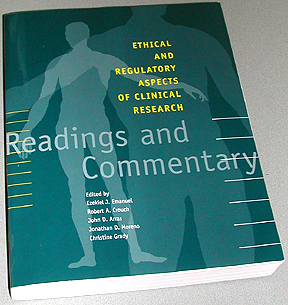| T H E N I H C A T A L Y S T | J A N U A R Y – F E B R U A R Y 2004 |
|
|
|
CRTP REVISITED: AN ALUMNUS PERSPECTIVE |
|
Uri
Lopatin
|
Ask Uri Lopatin about his experience in the Clinical Research Training Program (CRTP), and you’ll get a no-nonsense response: "Unabashedly one of the best academic experiences in my life. Period."
This comes as no surprise to anyone who knows Lopatin. One of the nine fellows in the CRTP inaugural class in 1997, he is now back at NIH for an infectious diseases fellowship that will center in the NIAID laboratory of Brian Kelsall, where he plans to study the role of the gastrointestinal dendritic cells in the mediation of immunologic tolerance.
Former NIH Director Harold Varmus, and OIR’s Michael Gottesman and Richard Wyatt, designed the CRTP to expose interested medical and dental students to clinical research—and to inspire them to pursue clinical research in their careers, much as Lopatin is doing.
CRTP fellows gain insight into translational research by participating in it from bench to bedside on the NIH campus for at least a year, says Frederick Ognibene, director of the program since 2000. It’s NIH’s way of "enticing those creative minds to follow a career as clinician scientists," he observes.
Students who have completed their clinical rotations and have permission from their home institution can apply for the program. Fellows attend ambulatory clinics, see patients on the wards, and work with an established NIH investigator in laboratories on selected clinical and translational research projects.
Fellows may stay a second year, depending on support from the sponsoring NIH institute and permission of the student’s home institutions.
When Lopatin had that opportunity, he grabbed it. A third-year medical student at the University of Medicine and Dentistry, New Jersey Medical School, Newark, he worked with Stephen Straus (now NCCAM director) in the NIAID Laboratory of Clinical Investigation elucidating the basic biological mechanisms of autoimmune lymphoproliferative syndrome. He also conducted chart reviews to assess clinical relevance, interviewed patients, and attended related seminars.
"I had these amazing opportunities as a medical student," Lopatin says—an experience that did indeed prove so enticing that after graduating from medical school and completing an internal medicine residency at New York University, Lopatin returned to NIH for a more intensive immersion in infectious diseases research. Now in the first year of the ACGME-accredited three-year fellowship, directed by John Bennett, Lopatin anticipates a future in academic medicine and, ideally, translational research.
Lopatin is not alone among CRTP alumni who are returning to NIH after completing their residencies. Joshua Kouri (CRTP 1998-1999) is doing a brain tumor fellowship in the NINDS Surgical Neurology Branch, and Will Savage (CRTP 1999-2000) will join the NIH–Johns Hopkins program in pediatric hematology-oncology in July 2004.
Begun with NIH funding, the CRTP attracted support during its second year from Pfizer Pharmaceuticals, which provided a grant to the Foundation for the NIH that enabled the program to grow from 9 to 15 scholars. Pfizer continues to provide financial support.
For the 2004-2005 academic year, the program has the potential to double its capacity, taking up to 30 fellows from medical and dental schools from all over the country. Support for the enlargement of the program has been provided by funds in the NIH Roadmap initiative addressing "re-engineering the clinical research enterprise."
For more CRTP information
and access to an online application, see this website.
![]()
 |
|
Published by the Johns Hopkins University Press, Baltimore
and London, 2003
|
ETHICAL AND REGULATORY ASPECTS OF CLINICAL RESEARCH: THE TEXTBOOK
The seven-week, 21-hour course in "Ethical and Regulatory Aspects of Clinical Research" that has taken NIH by storm since its inception in 1999—and has been taken on the road to developing countries since 2001—can now be absorbed at one’s leisure in a favorite reclining chair, or even under the trees by a lake.
An offering of the CC Department of Clinical Bioethics and directed by department chair Zeke Emanuel, the course has attracted a steadily increasing enrollment each fall—from 162 the first year to an overflowing 550+ this past fall.
The documentary substance that structures the course has been collected into a comprehensive and diverse text of nearly 500 pages, including 86 entries and nine appendices.
The text is edited by Emanuel and Christine Grady, who heads the department’s section on human subjects research, and three other prominent biomedical ethicists: Robert A. Crouch of McGill University, Montreal, and John Arras and Jonathan Moreno of the University of Virginia, Charlottesville.
It’s available at
the FAES Bookstore, Building 10, B1 level, and at other bookstores. Cost is
$39.95. ![]()
|
Contents Part I. Scandals and Tragedies of Research with Human Participants (including Nuremberg and Tuskegee) Part II. Ethical and Regulatory Guidance for Research with Humans (including the Declaration of Helsinki and the Belmont Report) Part III. The Ethics of Clinical Trial Design (including the distinction between research and treatment and the role of placebos in clinical research) Part IV. The Ethics of Research Participant Recruitment (including payment of research participants and informed consent) Part V. Informed Consent in Research Part VI. Clinical Research with Special Populations (including children and cognitively impaired people) Part VII. Special Topics in Research Ethics (including genetics, human embryos, stem cells, and international research) Part VIII. The Behavior of Clinical Investigators: Conflicts of Interest (including finder’s fees and the validity of clinical trials) Part IX. Scientific Misconduct (including altering data and the rules of authorship) Part
X. Challenges to the Institutional Review Board System (including
conflict of interest and commercial research review boards, and a central
institutional review board for multi-institutional trials)
|